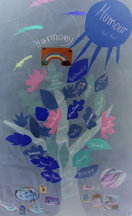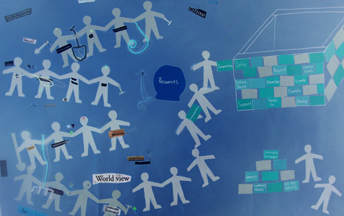The Learning Circles Project |
||
| Craft Circle, Toronto Council
Fire, Native Cultural Centre by Janice Brant |
||
In 1976, Toronto Council Fire began with a small group of people meeting in a church basement. They recognized that an increasing number of Indigenous people were gravitating to the downtown core and that many of them were disadvantaged and becoming homeless. By 1978 Council Fire was given a small space to operate and began receiving visits from mostly young Aboriginal men that had left their home communities, been released from institutions or traveled from other urban settings. Council Fire hosted regular potluck dinners that were a popular event and soon became a funded program serving all nationalities. As Council Fire grew, other support services were added to better serve a broad client base from infants to seniors. Some of their programs and activities include the Aboriginal All Weather Survival program, Life Long Care, First Nations Skills Development Program, Little Embers (Youth Program), Healing and Wellness, Drop-In, Aboriginal Healing Foundation, and Basic Skills (Literacy program). Equally important to the support services offered at Council Fire are the spiritual and personal needs of their clients. Council Fire continues to provide counselling, material assistance, and other direct services while encouraging and hosting circles that support and enhance the spiritual and personal growth of First Nations people. In 1997 Council Fire was able to establish a permanent home for their programs and services at their current location. The additional space has allowed for the expansion of support services such as skill development and training initiatives offered by the centre. Council Fire is a vibrant cultural agency that is committed to the well-being of Indigenous people in the greater Toronto area. Since the birth of Council Fire they have served as a host and sponsor to a number of learning circles that support and encourage cultural learning, healing, and self-awareness under the careful guidance of Elders, traditional teachers, volunteers and Council Fire staff. The Craft Circle serves as a sound example of the learning circles hosted by Council Fire. The Craft Circle evolved from a healing circle for residential school survivors, their families, and community members dealing with the intergenerational effects of the residential school era. The Craft Circle offered these people an opportunity to continue meeting, sharing, and healing while learning about and sharing their culture through hands-on activities. The circle was soon opened to include other urban Aboriginal people and their families, interested in learning and sharing Indigenous culture and traditional arts and crafts. Jayne Monague, Council Fire’s Healing and Wellness Coordinator states: “The circle is helping the Indigenous community to heal and grow stronger.” The Craft Circle has 12 regular participants ranging from young adults to people in their eighties that meet once a week on Tuesday or Thursday morning. The participants come from Scarborough, Etobicoke and the greater Toronto area to learn, create, share, and build community. Most of the Craft Circle participants have learned about the circle through word of mouth or were part of the original healing circle. Some participants have accessed this information in Council Fire’s monthly calendar in which Jayne posts their meetings. She also sends faxes to other Aboriginal organizations and agencies to inform the Indigenous community of their events and gatherings, as some agencies have referred their clients to the Craft Circle. The Craft Circle begins with an opening greeting circle, smudge, and lots of hugs. It is important that the participants of the circle feel welcome, loved, and supported. Participants of the Craft Circle operate like a family and offer emotional and spiritual nurturing. There is a great deal of interpersonal sharing that happens while participants work away at making their crafts. It is not uncommon for the circle to break for prayer during their gatherings in which they express their spiritual connections and send positive energy to the people that need their support. The Craft Circle is a place of healing and learning where participants share their lived experiences, build relationships, and care for one another. There are no prerequisites for joining the Craft Circle, everyone is welcome. The circle operates in a flexible manner and many of the crafting activities are initiated and facilitated by participants in the circle. According to Jayne, some of the participants now facilitate craft circles in other places. These individuals have learned through experience and are now able to move out into the community to share their skills and stories of healing with others. Occasionally, Council Fire staff members are called upon to share their skills and facilitate a traditional art or craft activity. Staff participation in the circle is dependant upon their availability. Participation in the Craft Circle is non-threatening and inclusive in that the traditional arts and craft activities are hands-on and experiential. Participants can learn and experiment with various materials at their own pace and with the support of others in the group. Print and/or written material is seldom used in the circle, although facilitators may introduce written and visual reference material from time to time. When handouts are used they are often very basic and include pictures and diagrams to illustrate the necessary steps in the process. In most cases instructions are given orally and participants are shown various techniques. Demonstrations are usually required of the facilitator, along with a sample of the finished product. This allows the participants to see the whole item or craft, rather than just parts of the whole. In order for the Craft Circle to get established, they were invited to use Council Fire crafting supplies with the understanding that as circle made various crafts such as necklaces, wristbands, chokers, and earrings they would donate some their finished items for craft sales. The craft sales would help the centre to replenish their craft supplies, as well as support further out reach activities in the Indigenous community. This arrangement works well for both Council Fire and the Craft Circle, although Jayne felt that the circle could benefit from financial support. This would assist some of the participants with the cost of transportation to and from the circle meetings. It would also help them to purchase more crafting supplies for more elaborate and intricate projects such as quilting and beading. It would also assist the circle in bringing forward new and more experienced crafters, instead of always relying upon volunteers to facilitate. They would also be able to offer an honorarium to Elders that visit the circle, share their teachings, skills and knowledge.
The Craft Circle is evaluated by attendance and oral narratives from the participants about their experience. As the coordinator of Healing and Wellness, Jayne is very interested in the Craft Circle and how participants work together; not only to organize their crafts, but also to engage in healing talk. Jayne has asked participants if their life is better as a result of the sharing and support that takes place in the Craft Circle. She has also used a brief questionnaire in the past to determine the impact of the Craft Circle on individual and family wellness. In closing, I realized that Council Fire was once a learning circle that evolved over time into a vibrant cultural organization committed to the well-being of the Indigenous community. Today, they are host to many learning circles, including the Craft Circle. |
||

